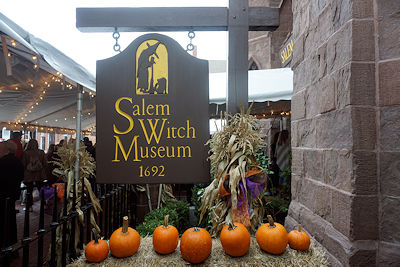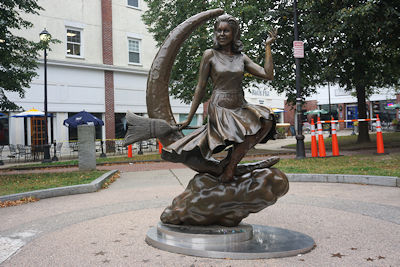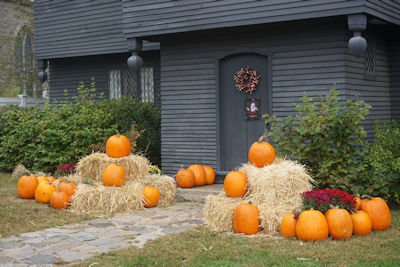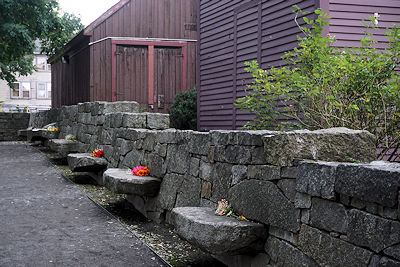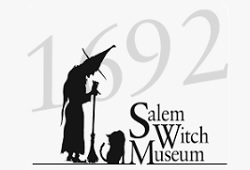
In 2005, the TV Land television channel – which specializes in airing classic television shows from the past – began erecting statues of iconic characters in the cities that they made famous, including Mary Tyler Moore in Minneapolis and Bob Newhart in Chicago. When it came time for the placement of a statue honoring Elizabeth Montgomery from the sitcom Bewitched, however, the decision was made to not locate it in Connecticut, where the series took place, but in Salem, Massachusetts, instead.
It turned out to be a controversial decision. “It’s a distortion of what went on,” longtime Salem resident told NPR at the time. “My wife’s great-great-great-whatever-grandmother was Elizabeth Norseph, and she was hung. We don’t make fun of the Holocaust, we shouldn’t be making fun of the witches.”
Stanley Usovicz, mayor of Salem at the time, had a different viewpoint. “This city has long recognized the true tragedy of 1692, so there is a great deal of culture here, historical culture,” he explained to NPR. “We don’t want to take away from that. But I think we also have to recognize that there is a popular culture and that we are part of that popular culture.”
Such conflicting opinions have raged in Salem for centuries. The Massachusetts city witnessed one of the darker moments in American history, a past from which it has been unable to escape but that also gave rise to a tourist economy that has benefited the region during hard times. Salem has thus been forced into a balancing act, one that recognizes that dark past in a respectful manner while also catering to the influx of tourists who keep Salem financially afloat.
From February 1692 until May 1693, mass hysteria gripped Salem when accusations of witchcraft were made against 200 of its residents. Thirty were in turn found guilty, with nineteen of them hung as witches, another “pressed” to death while at least five more died in jail. In the immediate aftermath, Massachusetts Governor William Phips banned any publications that mentioned the Salem Witch Trials in an effort to sweep the affair under the rug, but as historian Emerson W. Baker explains in his 2015 book A Storm of Witchcraft: The Salem Trials and the American Experience, the governor’s efforts were to no avail.
“The great age of witch hunts in Europe and America spanned roughly the period from 1400 to 1775,” Baker writes. “From Russia to Bermuda, from Scotland to Brazil, witch hunts took place throughout the European world. During that time about a hundred thousand people were sentenced to death. By European standards, Salem was not even a large witch hunt, nor was it the last. Yet no place has acquired such infamy as Witch City.”
Despite efforts to forget and move on within the small Massachusetts enclave, the rest of world regularly cited Salem throughout the eighteenth century when discussing the horrors of witch hunts. During the nineteenth century, meanwhile, the Salem Witch Trials made their way into fictional works, including those of Nathanial Hawthorn, whose House of Seven Gables was published in 1851.
“Nathanial Hawthorne reminded readers of the dark side of that past,” Emerson Baker explains in A Storm of Witchcraft. “Indeed, no figure played a larger role in establishing Salem’s place in the American imagination than Hawthorne. The Salem native son was a direct descendant of Judge Hathorne (Nathanial added the w to his name soon after graduating from Bowdoin College). He never gave his reasons for the change, though many have suggested it was either to distance himself from his ancestor or to add his own personal scarlet letter to the family name – w for witch.”
As the notoriety of Salem increased, so did the number of visitors to the city. By 1880, the Massachusetts city was attracting thirty thousand tourists a year. As the two hundredth anniversary of the Witch Trials grew closer, meanwhile, so did commercialism, with a witch emblem emblazed on the cover of the 1892 Visitor’s Guide to Salem, which also included advertisements for Witch Cream skin lotion and witchcraft souvenir spoons.
1892 likewise marked the first efforts by Salem to honor the victims of the Witch Trials with a memorial within the city. Just as the erection of the Bewitched statue would be met with controversy over one hundred years later, the same occurred in 1892, with opponents arguing that “the whole affair ought to be cast into oblivion as too horrible to contemplate,” as well as fears that such a memorial might offend the families whose ancestors participated in the persecution of their fellow neighbors. In the end, there was no memorial.
During the early years of the twentieth century, Salem’s fortunes began to erode, with many of the industries that had originally fueled the local economy falling to the wayside. Tourism quickly took their place, but local politicians were still unwilling to officially acknowledge the Salem Witch Trials.
That would change mid-century, however, with the premier of Arthur Miller’s play The Crucible in 1953. Using the Salem Witch Trials as a metaphor for the McCarthy hearings being held in the United States Senate against suspected communists, The Crucible won the Tony Award for Best Play and remains a classic of contemporary drama to this day.
By 1962, the Salem Evening News included a witch on a broomstick to its logo, and both the Salem Chamber of Commerce and Police Department followed suit shortly thereafter, adding the moniker “Witch City” as well. In 1970, meanwhile, eight episodes of Bewitched were filmed in Salem with a narrative centered on an annual witch’s convention. Watched by millions at the time, the television sitcom increased the number of tourists visiting Salem even more.
It wasn’t just tourists, however, as modern day Wiccans – members of a contemporary Pagan religion based on pre-Christian traditions – not only visited Salem but also decided to make it their home. Laurie Cabot was the first, arriving in 1971 and opening a small store that sold witchcraft-related items like herbs and Tarot Cards. It is now estimated that ten percent of Salem’s 40,000 residents are Wiccans.
The Salem Witch Museum – which tells the story of the Witch Trials through thirteen life-size sets complimented by dramatic lighting and narration – then opened in 1972. The effect was instantaneous, with over one million people visiting Salem a mere two years afterwards, leading to additional museums intent on cashing in, including the Witch Dungeon Museum and Witch History Museum.
Other museums likewise now exist in Salem, many of which having nothing to do with the Salem Witch Trials, or even witches in general. Count Orlok’s Nightmare Gallery Monster Museum, the Salem Wax Museum, the Satanic Temple, and the Salem Halloween Museum can all be found within the city limits.
While Salem is still reluctant to acknowledge its past, it has embraced tourism, billing itself as the “Halloween Capital of the World” with a “Haunted Happenings” celebration of witches, goblins, and ghouls throughout the month of October. The designation has paid off handsomely, with an estimated annual attendance of four hundred thousand and $9 million in revenue.
The city of Salem, Massachusetts, finally has a Salem Witch Trials Memorial as well, although one that is low key in nature. Located next to the Charter Street Cemetery – which does not contain the graves of any of the Witch Trials’ victims – the horseshoe shaped path features twenty granite benches, each inscribed with the name of those put to death and the date that they died.
“There still is much public debate in Salem about the proper way to acknowledge its heritage,” Emerson Baker writes in A Storm of Witchcraft. “The community seems sometimes reluctant to deal honestly with the associations that saddle it, particularly when it benefits from those associations. ‘Witch City’ brings in tourists, businesses, and income. And one could argue that it is not merely latter-day cynical exploitation but instead a way of owning up to the past, that it represents Salem’s own scarlet letter, which it willingly bears, in remembrance and in repentance.”
The Witch Trials are now remembered in Salem and their victims not forgotten, but that remembrance shares the spotlight with a month-long Halloween celebration and a community of modern day Wiccans as residents. A metaphorical dark cloud still hangs overhead, however, much like the weather during the month of October that has become so vital for the local economy.
Anthony Letizia
